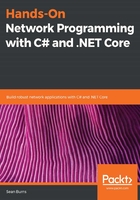
The Stream class
If you've done any reading or writing of files on your local file system in C# on older .NET Framework versions, you'll already be familiar with this concept. In .NET Core, we can import the System.IO namespace to our application to start working directly with the data returned by a TCP/IP socket by simply opening up a new StreamReader object, initialized with a NetworkStream instance connected to the target socket. So, what is a stream and how should you use it?
Streams are a powerful concept in processing serialized data. They provide one-way access to a sequential data source and allow you to handle the processing of that data explicitly. Executing the Read() or ReadAsAsync() methods, or other associated methods, will trigger this one-way traversal; starting at the beginning and reading, on demand, byte by byte through the entire sequence, until a Terminal character has been reached. The .NET implementation of this concept is extremely flexible, such that, regardless of the specific instance of the Stream abstract class you're using, the StreamReader class will be equipped to accept the data, traverse it accordingly, and allow you to build out a non-serialized instance of a C# data structure as needed.
We'll examine streams more thoroughly in later chapters, but for now, I wanted to highlight how, in the context of network communication, streams are composed of the sequence of packets received by a specific port or socket, and returned to your application through a normalized implementation of the Stream class.
This is just one example of the power suite of abstractions provided by .NET Core. So, even though you now have the understanding necessary to explicitly handle individual packets returned from your transport layer to rebuild the response of a network request from scratch, you thankfully never have to do that. The Core framework handles that headache for you. And with this added perspective of what's happening under the hood, I hope you feel better equipped to address potential performance issues or subtle network bugs in your network-dependent applications going forward.